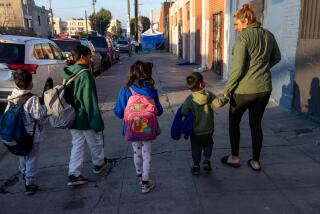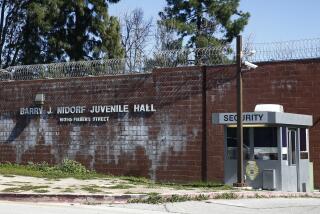BUENA PARK : Anti-Gang Program Wins $31,821 Grant
The city recently awarded a Community Development Block Grant of more than $31,000 to support a gang prevention program run by the Police Department and aimed at fifth-graders.
The educational program, Positive Avenues for Youth, was presented to 1,200 students in every fifth-grade class in the city this year.
Although much of the program is suspended during the summer months, gang prevention adviser Barbara Baiz said the $31,821 grant will help the program continue to refer families to youth activities and services and prepare for the upcoming school year.
Positive Avenues for Youth, now in its second year, is the only gang prevention program in the county that is administered by a police department, Baiz said.
“Police departments are usually not in the business of prevention. They are into crime suppression and enforcement of the law,” she said. “We’re making a very unique effort in Buena Park.”
The 10-unit program includes information about gangs, violence, graffiti, drug abuse, peer pressure and the impact on the family and the community. Baiz also explains the legal consequences of gang membership, covering laws pertaining to youths and the juvenile justice system.
Students see slides of Juvenile Hall as part of the presentation.
“Most of them had no idea,” she said. “It was the first time they learned there was a Juvenile Hall, that there was a jail for young people. (The program) is very important because no one is out there educating the young people on the law.”
The fifth-graders spent the last semester learning about city ordinances that prohibit a juvenile to have a can of spray paint with the intent of defacing property, and that it is illegal for a store owner to sell it to them. They also learned that older youths could have their driver’s licenses suspended or the date of issue postponed if they are convicted of vandalism.
The program also explains curfew laws and defines probation and the differences among Juvenile Hall, the California Youth Authority and state prisons.
“More than anything, we want to give them a realistic view of when an individual joins a gang and becomes involved in the juvenile justice system, because they often go hand-in-hand,” Baiz said.
An important part of the program is parent involvement, she said. Many times, students are required to return flyers and brochures that have been signed by their parents and are encouraged to share the information with other members of their family.
“What we’ve found is that a lot of the parents aren’t even aware that their children are in the gangs,” she said. “The root of the problem is not just the parents, but we really need to get them involved just to keep that communication going with their children.”
Baiz, 32, had worked in the La Habra Police Department as a youth services officer, where she came into contact with first-time offenders. She joined the Buena Park program in October.
“There are very few times that first-time offenders are aware that they broke the law. In the juvenile justice system, if you commit a crime for the first time, you are sent to a diversion program to learn about crime,” she said. “We do that here.”
More to Read
Sign up for Essential California
The most important California stories and recommendations in your inbox every morning.
You may occasionally receive promotional content from the Los Angeles Times.










